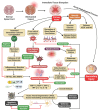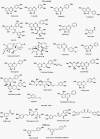Polyphenols Targeting NF-κB Pathway in Neurological Disorders: What We Know So Far?
- PMID: 38385077
- PMCID: PMC10878147
- DOI: 10.7150/ijbs.90982
Polyphenols Targeting NF-κB Pathway in Neurological Disorders: What We Know So Far?
Abstract
Polyphenolic compounds have shown promising neuroprotective properties, making them a valuable resource for identifying prospective drug candidates to treat several neurological disorders (NDs). Numerous studies have reported that polyphenols can disrupt the nuclear factor kappa B(NF-κB) pathway by inhibiting the phosphorylation or ubiquitination of signaling molecules, which further prevents the degradation of IκB. Additionally, they prevent NF-κB translocation to the nucleus and pro-inflammatory cytokine production. Polyphenols such as curcumin, resveratrol, and pterostilbene had significant inhibitory effects on NF-κB, making them promising candidates for treating NDs. Recent experimental findings suggest that polyphenols possess a wide range of pharmacological properties. Notably, much attention has been directed towards their potential therapeutic effects in NDs such as Alzheimer's disease (AD), Parkinson's disease (PD), cerebral ischemia, anxiety, depression, autism, and spinal cord injury (SCI). Much preclinical data supporting the neurotherapeutic benefits of polyphenols has been developed. Nevertheless, this study has described the significance of polyphenols as potential neurotherapeutic agents, specifically emphasizing their impact on the NF-κB pathway. This article offers a comprehensive analysis of the involvement of polyphenols in NDs, including both preclinical and clinical perspectives.
Keywords: Alzheimer's disease; NF-κB pathway; Neuroinflammation; Parkinson's disease; Polyphenols; neurological disorders; spinal cord injury.
© The author(s).
Conflict of interest statement
Competing Interests: The authors have declared that no competing interest exists.
Figures




References
-
- Mehndiratta MM, Aggarwal V. Neurological disorders in India: past, present, and next steps. Lancet Glob Heal. 2021;9:e1043–4. - PubMed
-
- Rahman MH, Bajgai J, Fadriquela A. et al. Redox effects of molecular hydrogen and its therapeutic efficacy in the treatment of neurodegenerative diseases. Processes. 2021;9:1–17.
-
- Salvadores N, Court FA. The necroptosis pathway and its role in age-related neurodegenerative diseases: will it open up new therapeutic avenues in the next decade? Expert Opin Ther Targets. 2020;24:679–93. - PubMed
Publication types
MeSH terms
Substances
LinkOut - more resources
Full Text Sources
Medical

